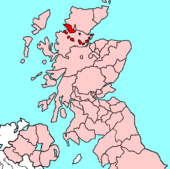Cromartyshire: Difference between revisions
No edit summary |
Some more material |
||
| Line 9: | Line 9: | ||
|biggest town=[[Ullapool]] | |biggest town=[[Ullapool]] | ||
}} | }} | ||
The '''County of Cromarty''' is a [[Counties of the United Kingdom|shire]] of the [[Highlands of Scotland]], and certainly the most unusual in form. Cromartyshire consists of a number of physically-separated areas scattered across Ross from the east to the west coast. | The '''County of Cromarty''' is a [[Counties of the United Kingdom|shire]] of the [[Highlands of Scotland]], and certainly the most unusual in form. Cromartyshire consists of a number of physically-separated areas scattered across Ross from the east to the west coast. For this reason it is common to consider the geography of Cromartyshire and of Ross-shire together, the two being in practical terms inseparable. | ||
[[Cromarty]] stands on the Black Isle on the North Sea coast, while the county's largest town, the fishing village of Ullapool, stands on the Atlantic coast. | [[Cromarty]] is the [[county town]]. It stands on the Black Isle on the North Sea coast, while the county's largest town, the fishing village of [[Ullapool]], stands on the Atlantic coast. | ||
The arrangement of scattered parcels as one shire arises from the seventeenth century and the influence of George Mackenzie when the sheriff of Cromarty in 1685 and 1698. An influential man in the court in the days of King Charles II, James VII and William and Mary, he owned several estates in Cromartyshire as it was and in Ross and he sought to bring them together into one county, which was duly enacted. Mackenzie was later ennobled as Earl of Cromarty. | |||
==The portions of Cromartyshire== | |||
Cromartyshire consists of twenty-three separated portions. Other counties with some detached parts have a main body of the county and detached parts nearby and in following that practice it is usual to consider the principal portion to be that containing the county town, Cromarty, but this is not the largest portion of the county but the second-largest, and is just one-sixth the size of the largest portion, the district of [[Coigach]] in the northwest. | |||
{{stub}} | {{stub}} | ||
{{British county}} | {{British county}} | ||
Revision as of 17:32, 16 December 2011
| Cromartyshire United Kingdom | |

| |
|---|---|
| [Interactive map] | |
| Area: | 370 square miles |
| Population: | 71,536 (with Ross-shire) |
| County town: | Cromarty |
| Biggest town: | Ullapool |
| County flower: | Spring cinquefoil [1] |
The County of Cromarty is a shire of the Highlands of Scotland, and certainly the most unusual in form. Cromartyshire consists of a number of physically-separated areas scattered across Ross from the east to the west coast. For this reason it is common to consider the geography of Cromartyshire and of Ross-shire together, the two being in practical terms inseparable.
Cromarty is the county town. It stands on the Black Isle on the North Sea coast, while the county's largest town, the fishing village of Ullapool, stands on the Atlantic coast.
The arrangement of scattered parcels as one shire arises from the seventeenth century and the influence of George Mackenzie when the sheriff of Cromarty in 1685 and 1698. An influential man in the court in the days of King Charles II, James VII and William and Mary, he owned several estates in Cromartyshire as it was and in Ross and he sought to bring them together into one county, which was duly enacted. Mackenzie was later ennobled as Earl of Cromarty.
The portions of Cromartyshire
Cromartyshire consists of twenty-three separated portions. Other counties with some detached parts have a main body of the county and detached parts nearby and in following that practice it is usual to consider the principal portion to be that containing the county town, Cromarty, but this is not the largest portion of the county but the second-largest, and is just one-sixth the size of the largest portion, the district of Coigach in the northwest.
This county article is a stub: help to improve Wikishire by building it up.
| Counties of the United Kingdom |
|---|
|
Aberdeen • Anglesey • Angus • Antrim • Argyll • Armagh • Ayr • Banff • Bedford • Berks • Berwick • Brecknock • Buckingham • Bute • Caernarfon • Caithness • Cambridge • Cardigan • Carmarthen • Chester • Clackmannan • Cornwall • Cromarty • Cumberland • Denbigh • Derby • Devon • Dorset • Down • Dumfries • Dunbarton • Durham • East Lothian • Essex • Fermanagh • Fife • Flint • Glamorgan • Gloucester • Hants • Hereford • Hertford • Huntingdon • Inverness • Kent • Kincardine • Kinross • Kirkcudbright • Lanark • Lancaster • Leicester • Lincoln • Londonderry • Merioneth • Middlesex • Midlothian • Monmouth • Montgomery • Moray • Nairn • Norfolk • Northampton • Northumberland • Nottingham • Orkney • Oxford • Peebles • Pembroke • Perth • Radnor • Renfrew • Ross • Roxburgh • Rutland • Selkirk • Shetland • Salop • Somerset • Stafford • Stirling • Suffolk • Surrey • Sussex • Sutherland • Tyrone • Warwick • West Lothian • Westmorland • Wigtown • Wilts • Worcester • York |